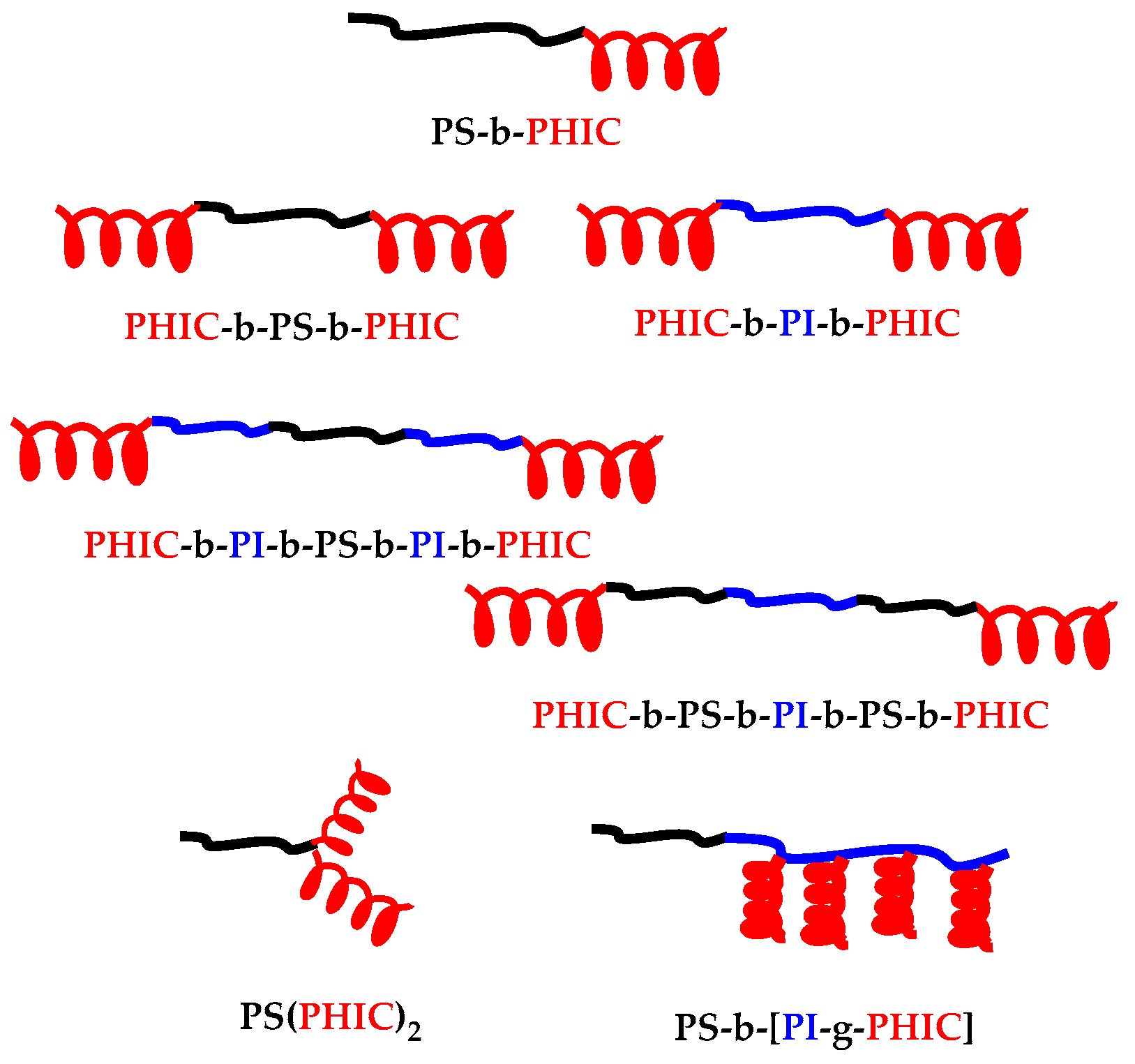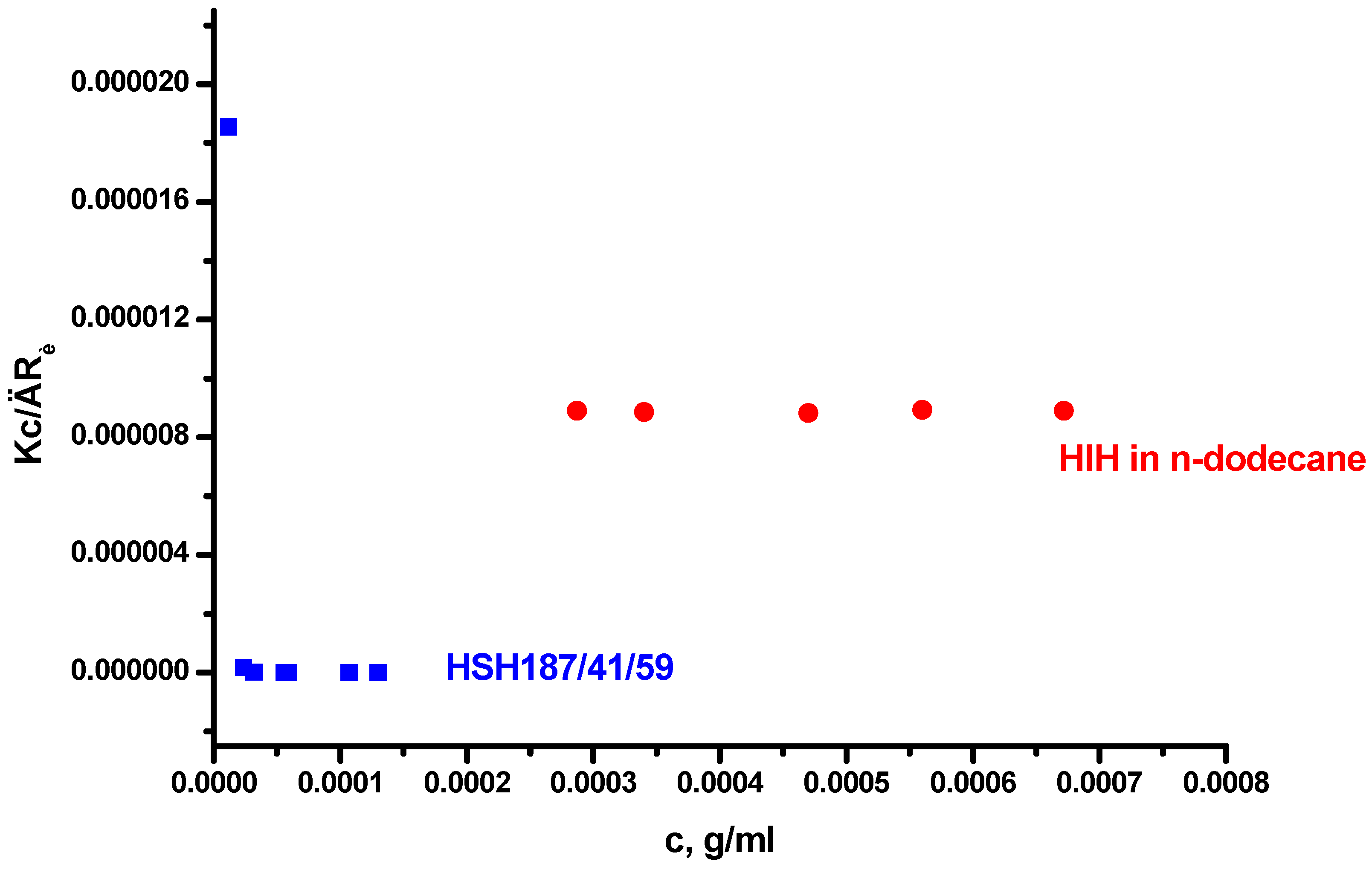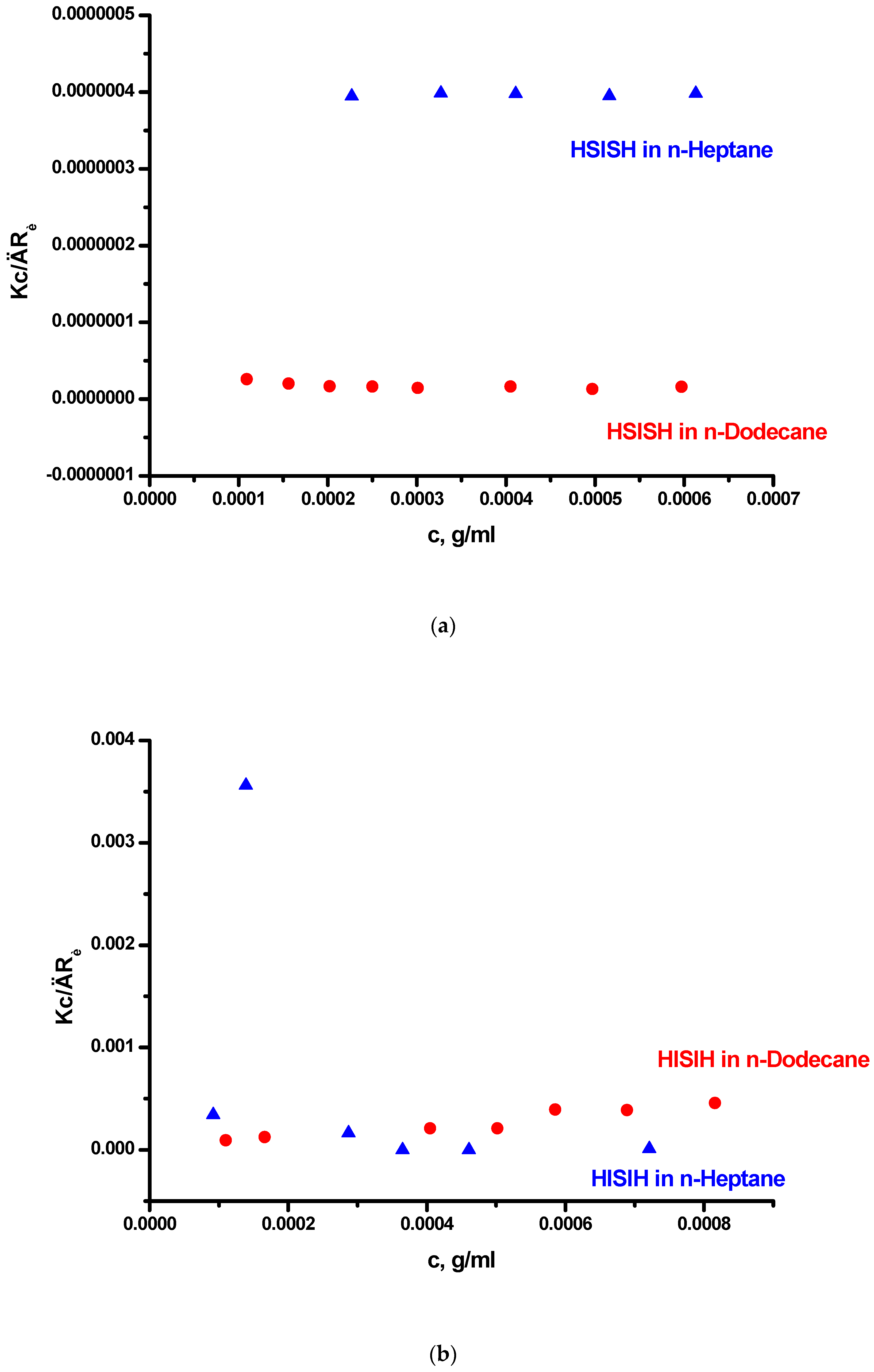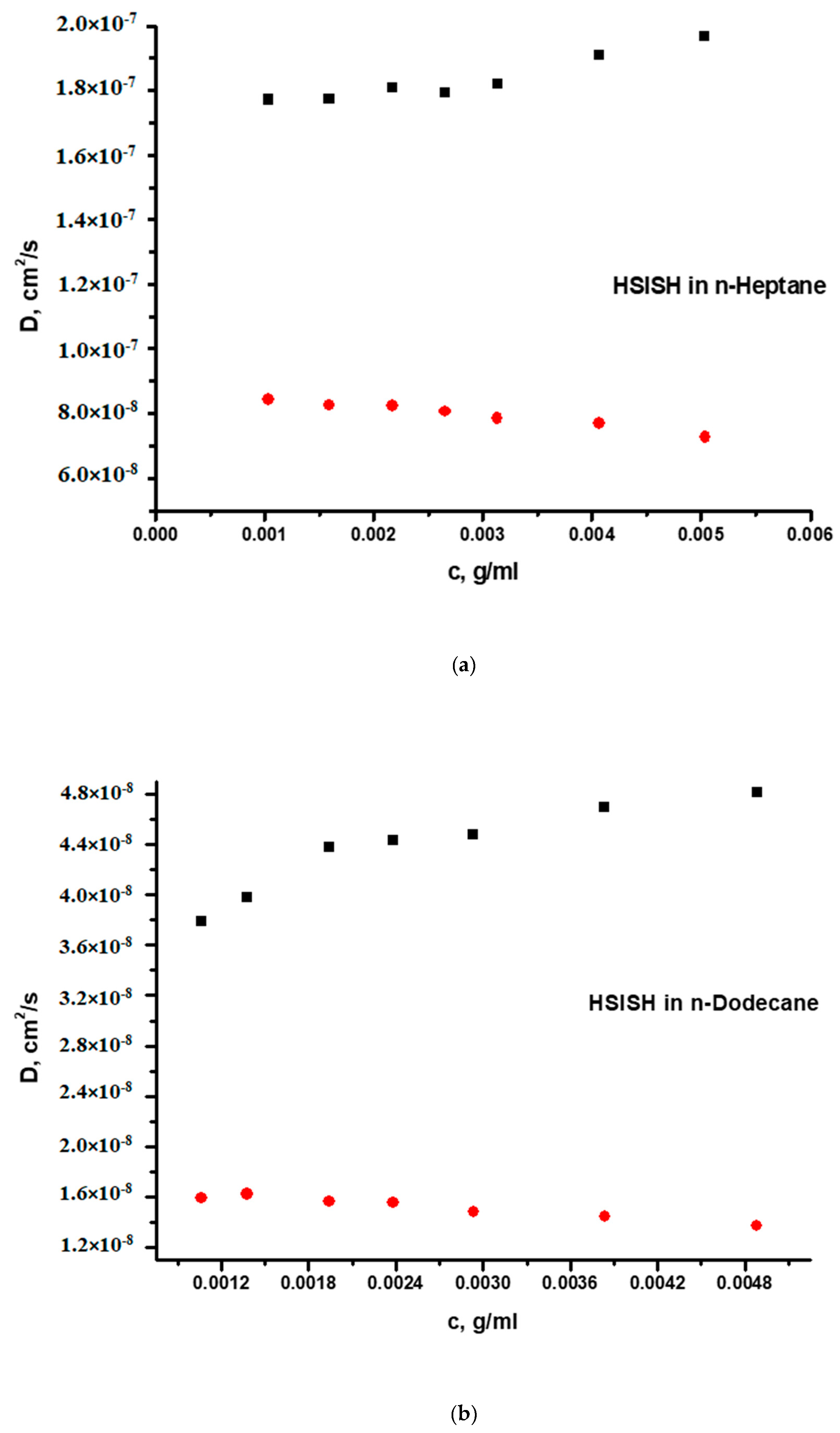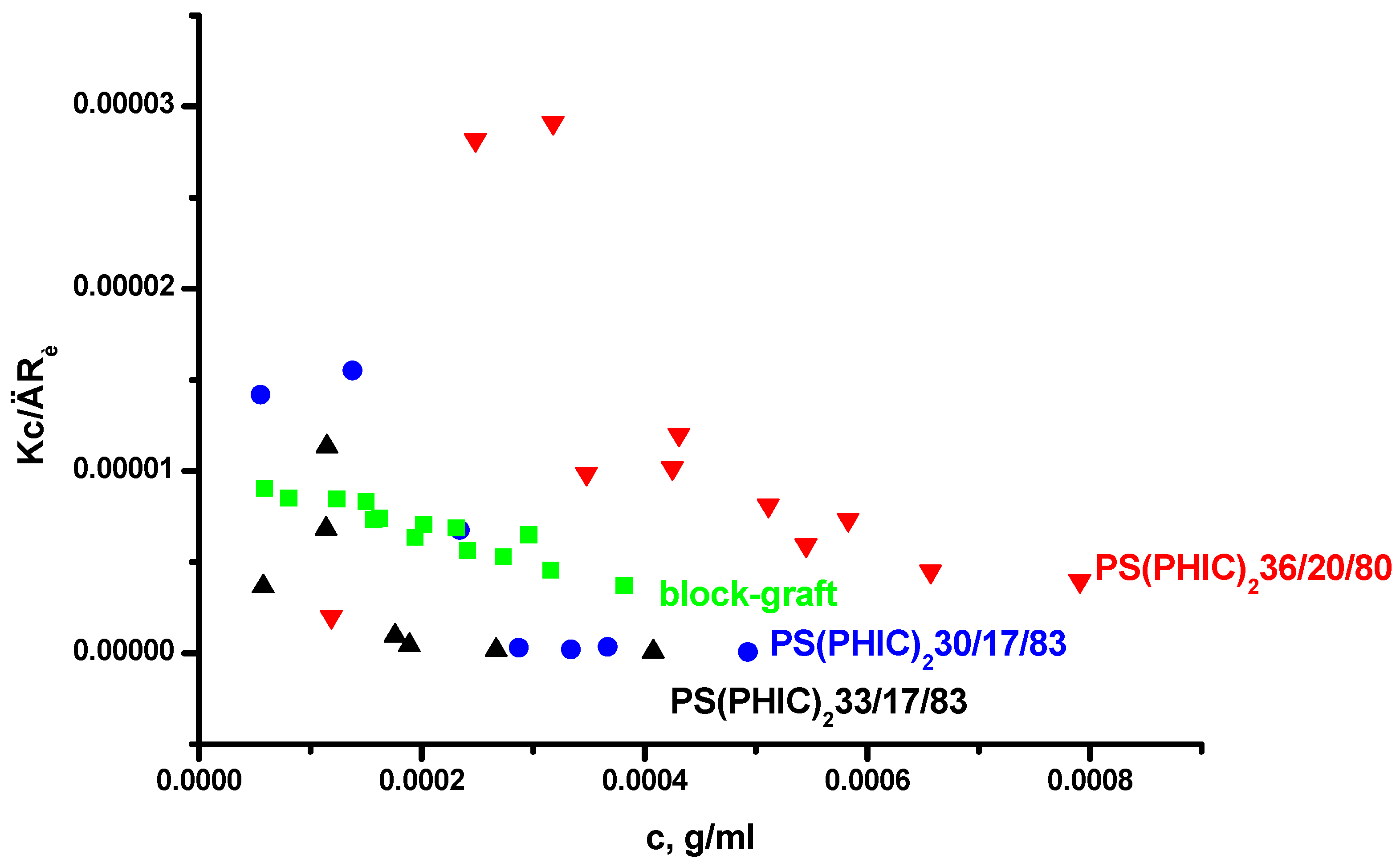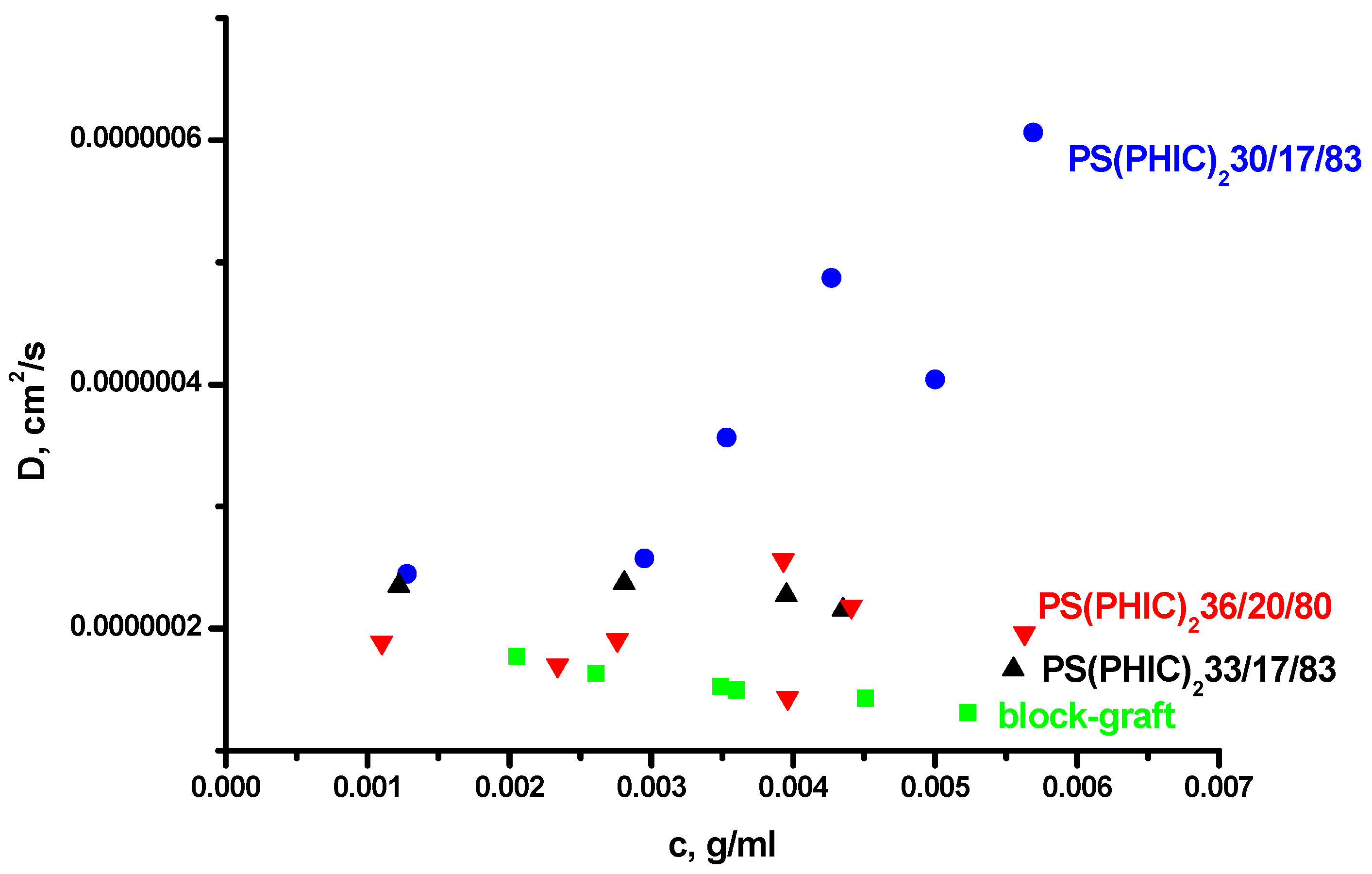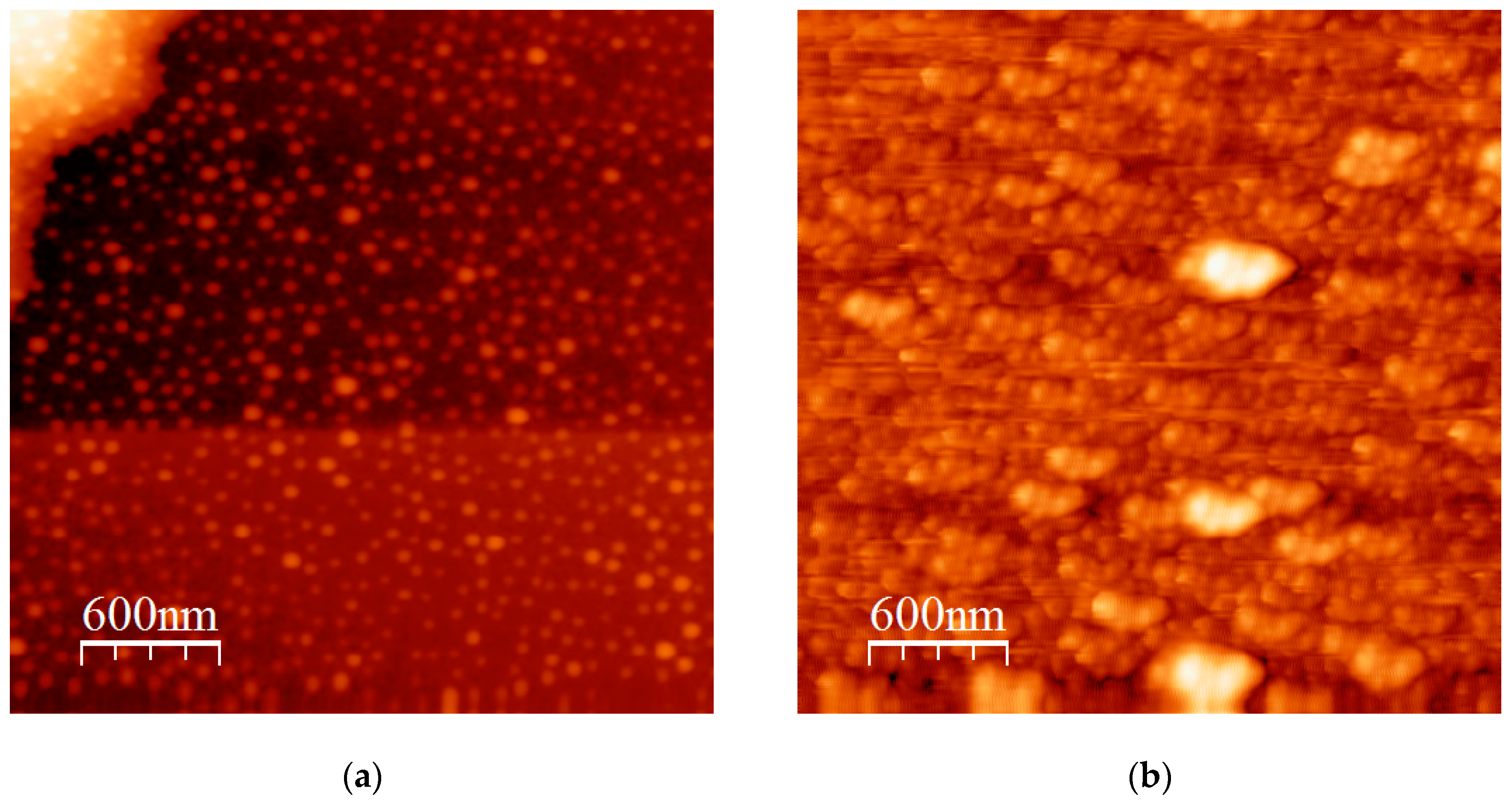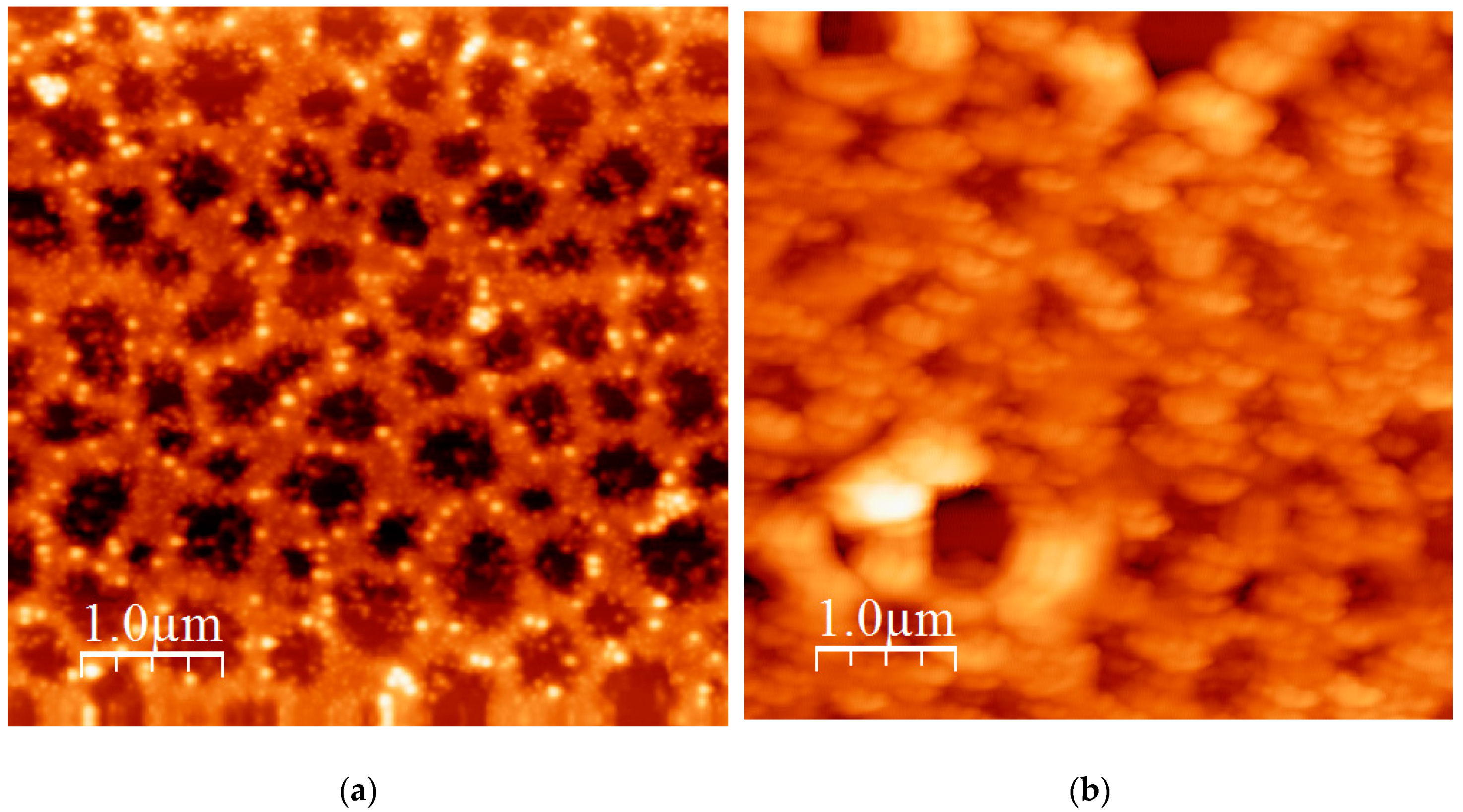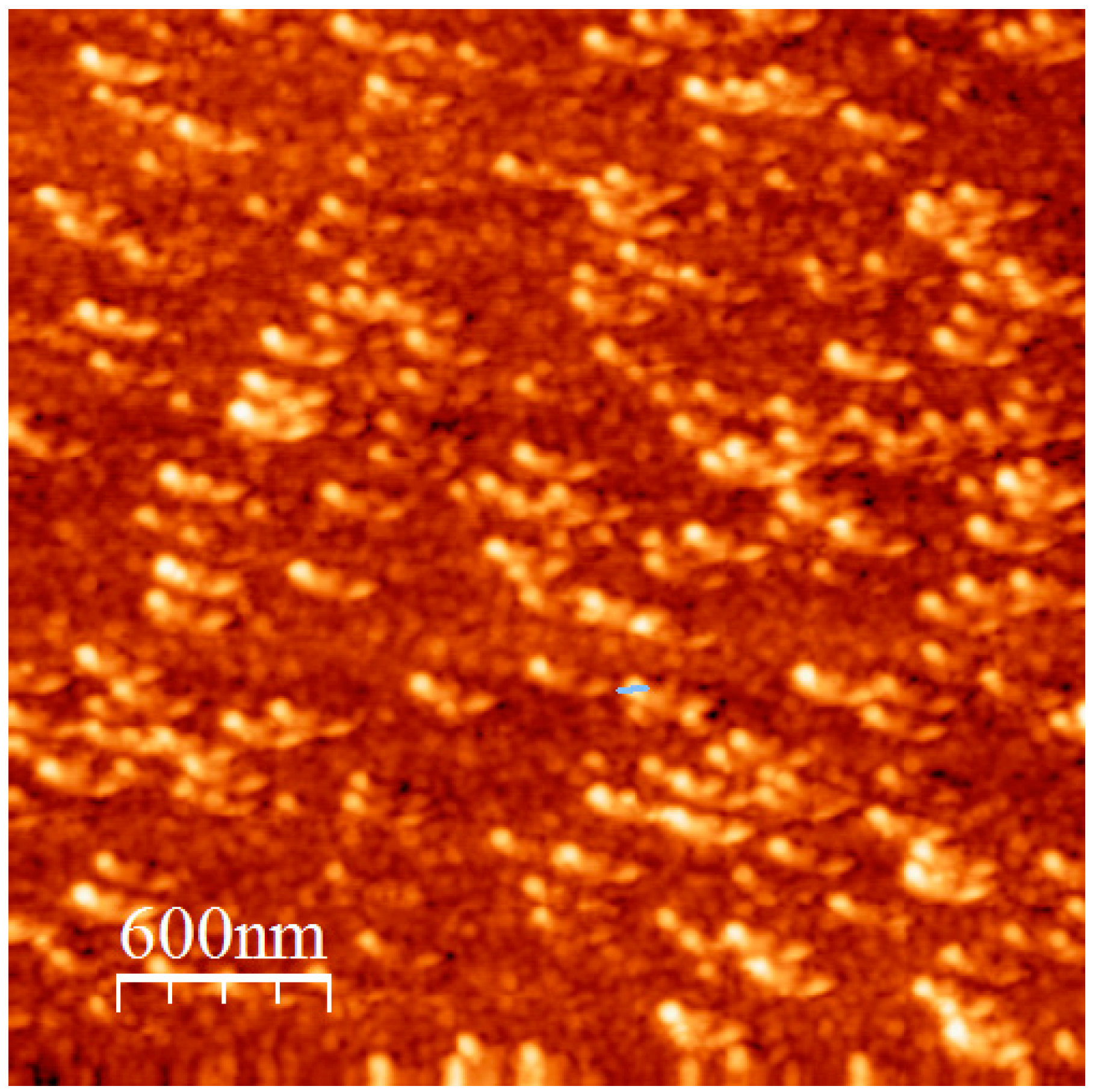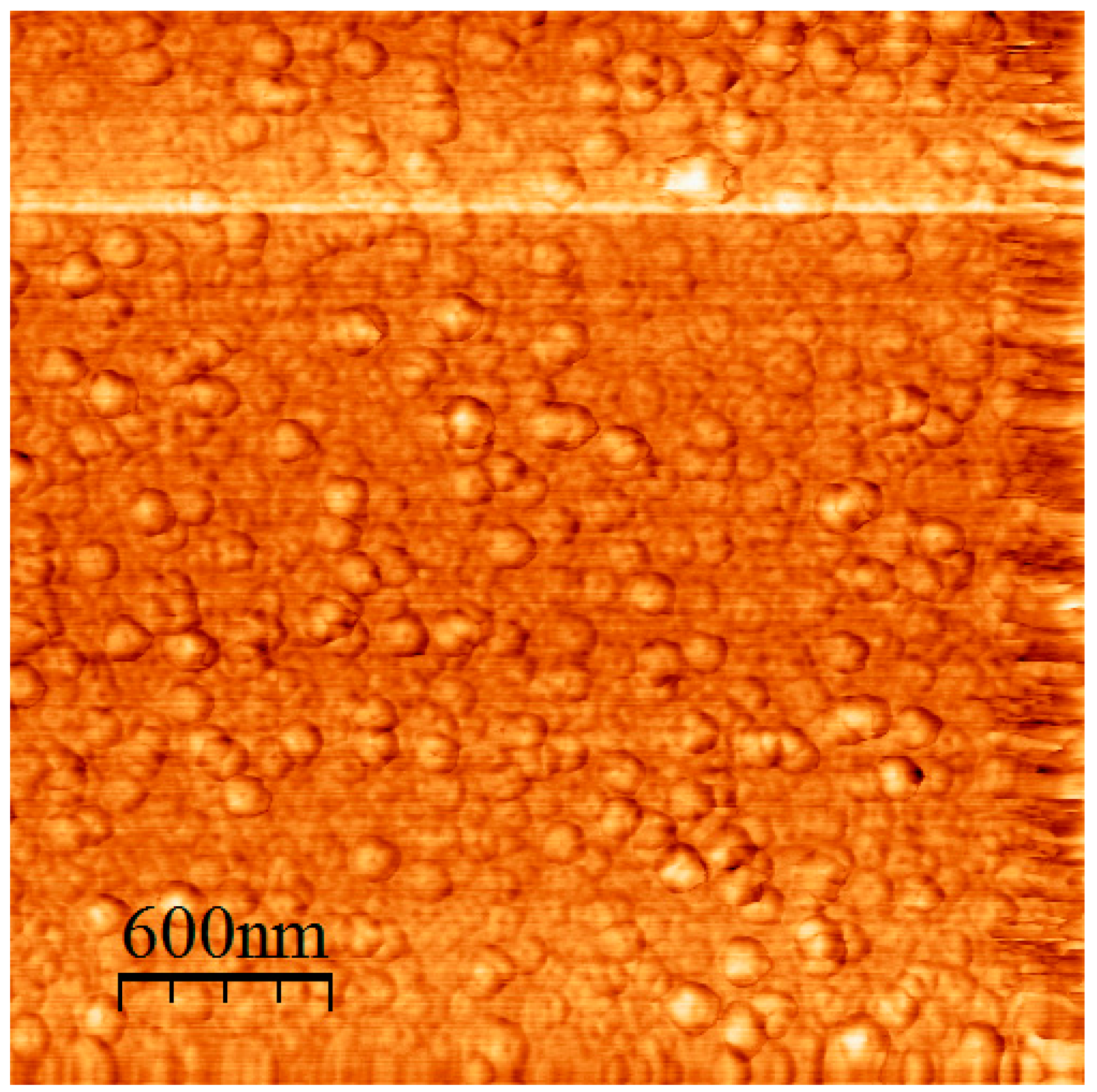3.1. Micellization Behavior of PS-b-PHIC, SH Block Copolymers in n-Heptane
The diblock copolymers having polystyrene (PS) and PHIC blocks were synthesized either by anionic (SH121/90/10 and SH187/92/8) or by coordination polymerization techniques (SH14/3/97, SH7.5/9/91, SH19.5/11/89 and SH14/18/82) [
44,
45,
46,
47,
48,
49,
50]. The samples are symbolized as SH followed by numbers denoting the sample’s molecular weight (in KDa), the % wt content is PS and the % wt content in PHIC. The molecular characteristics are given in
Table 1. The micellar solutions were obtained in n-heptane, which is a selective solvent for the PHIC block. In other words, the micelles consist of a core from the amorphous and glassy PS chains and a soluble corona from the rod-like PHIC chains. The samples with the rather small amount of PS were directly dissolved in the selective solvent. The dissolution was facilitated by heating the n-heptane solution at 60 °C under argon atmosphere overnight. Taking into account the low molecular weight of the PS blocks and their subsequently lower Tg values, this thermal treatment is able to provide enough mobility to the PS blocks in order to achieve the formation of equilibrium micellar structures. The last two samples with the highest PS content were not directly soluble in the selective solvent. In this case, the micellization was promoted by dissolving the block copolymers in a mixture of the selective solvent along with the minimum amount of the common good solvent THF. In this mixture, the block copolymers are readily dissolved and gradual evaporation of the volatile THF leaves stable micellar solutions with the characteristic blue tint, which ensures the formation of large supramolecular structures. All micellar solutions were stable over a period of several weeks.
The LALLS data of the linear SH block copolymers in n-heptane are given in
Table 1, whereas characteristic plots are provided in
Figure 1. The weight average degree of association, N
w, defined as the ratio of M
w measured in the selective solvent over M
w of the diblock in the common good solvent THF, increases upon increasing the PS content. Sample SH14/3/97 with only 3% wt PS leads to almost unimolecular micelles with an average degree of association, N
w, equal to 1.4. Going to the extreme case, where PS dominates within the copolymer structure (samples SH121/90/10 and SH187/92/8 containing more than 90% PS), the N
w values increase dramatically to more than 1300. The LALLS plots for samples SH14/3/97, SH7.5/9/81, SH19.5/11/89 and SH14/18/82 are linear over the concentration range examined, i.e., the critical micelle concentration (CMC) is much lower than the lowest experimentally accessible concentration (approximately 2 × 10
−3 g/mL), and stable micellar structures exist in that concentration regime. Samples SH121/90/10 and SH187/92/8 show stable micellar structures at concentrations higher than 1.5 × 10
−5 g/mL. At lower concentrations, much lower apparent molecular weights were obtained, indicating the ongoing association process. However, even for these two samples, it was not possible to identify the CMC values by LALLS measurements. The LALLS plots for these samples are incorporated in the
Supplementary Materials Section, SMS. The second virial coefficients are very low, even in the cases of micelles with low N
w values, indicating weak interactions of the supramolecular species and the selective solvent.
The DLS data of block copolymers in n-heptane are given in
Table 1. The plots are linear (characteristic examples are given in the SMS) but with very low k
D values. This result is in agreement with the low A
2 values obtained in the selective solvent, since k
D and A
2 are related through the following equation:
where M is the molecular weight, k
f is the coefficient of the concentration dependence of the friction coefficient and u is the partial specific volume of the polymer. Due to the similar molecular weights in both solvents, THF and n-heptane, a decrease in A
2 is accompanied by a decrease in k
D as well. CONTIN analysis provided suitable insight into the self-assembly process and the formation of the supramolecular structures.
Sample SH14/3/97, with the lowest PS content, forms very small spherical structures, as revealed by their low size along with the absence of any angular dependence in DLS measurements. The polydispersity factor μ2/Γ2, where Γ is the decay rate of the correlation function and μ2 is the second moment of the cumulant analysis, is always lower than 0.1, indicating the presence of monodisperse small micellar structures.
CONTIN analysis for samples SH7.5/9/81, SH19.5/11/89 and SH14/18/82 revealed the presence of bimodal distributions, indicating the presence of higher-order equilibrium in solution. Judging from the relative Rh values of the different populations, it is obvious that equilibrium between micelles and clusters exist. For samples SH19.5/11/89 and SH7.5/9/91, the clusters are the minority component (less than 10% by intensity), but for sample SH14/18/82, the contribution of the clusters is much more pronounced (higher than 30% by intensity). In all cases, however, the micelles are spherical (there is no angular dependence) and thermally stable up to 55 °C. In addition, the micelles are almost monodispersed, taking into account the lower than 0.1 values of the polydispersity factor μ2/Γ2.
Samples SH121/90/10 and SH187/92/8 with the highest Nw values show unimodal distributions in CONTIN analysis. As revealed in the other cases, the micelles are spherical and monodispersed with polydispersity factor values μ2/Γ2 of 0.05. They are also thermally stable up to 55 °C. Despite the very high Nw values of samples SH121/90/10 and SH187/92/8, their Rh values are not so high, indicating that the micelles are very compact and behave more or less as hard spheres.
The thermal stability of all micelles can be explained considering that the core material is the amorphous and glassy PS with high Tg value and, more importantly, that the corona material is the stiff and helical PHIC, which does not appreciably change conformation at the temperature range examined in this work.
Several theoretical models have been proposed to describe the micelle structure. The case of micelles consisting of small cores and large coronas can be well described by the star model. If N
A and N
B are the lengths of the corona and core-forming blocks A and B, respectively, the star model will be valuable when N
A >> N
B. According to the Halperin’s star model [
69], the following scaling relationships between the parameters of interest for block copolymers can be obtained:
The other limiting case is the situation of micelles consisting of a large core and a relatively thin corona, i.e., when N
B >> N
A can be described by mean density models [
70,
71,
72]. According to these models, the volume fraction of the A segments in the corona is assumed to be independent of the distance from the core. The following scaling relationships are obtained:
To further test the validity of these models, the radius of the micellar core was calculated using the following equation:
where M
w,mic is the micellar molecular weight, wt
PS is the weight fraction of the core-forming block, d
PS is the density of PS and φ
PS is the volume fraction of PS in the core. The density of PS is equal to 1.05 (d
PS = 1.05). Two limiting cases were considered: the dry core (φ
PS = 1) and the swollen core (φ
PS = 0.5). The results for both cases are given in
Table 2. In addition, the area of the core-corona interface, A
c, occupied per copolymer chain is given as follows:
The A
c values for the dry and swollen core cases are also reported in
Table 2.
Judging from the high PS content of samples SH121/90/10 and SH187/92/8, it is obvious that the micellar core should be extended and that the supramolecular structures should behave as crew-cut micelles. This assumption was verified by the almost stable values of the ratio Rh/NB2/3, the high values of Rc compared to the corresponding Rh of the micelles and the low Ac values considering both the dry and the swollen core cases.
On the other hand, the low PS contents of samples SH14/3/97, SH7.5/9/81, SH19.5/11/89 and SH14/18/82 support the application of the star model for their micellar structures. The Rh/(NB4/25 NA3/5) ratios were, nevertheless, not very stable as would be expected. The reason for this is the fact that there is a small but recorded tendency for the formation of clusters through intermicellar association, which causes deviations from the pure star model, and most importantly that the PHIC corona material is actually very stiff and does not change easily conformations. The star model is more adequate for flexible polymeric chains. However, the relatively low Rc and high Ac values are more consistent with a star-like structure. These conclusions will be further confirmed by AFM measurements.
3.2. Micellization Behavior of PHIC-b-PS-b-PHIC, HSH, Triblock Copolymers in n-Heptane and PHIC-b-PI-b-PHIC, HIH, Triblock Copolymer in n-Dodecane
The symmetric triblock copolymers PHIC-b-PS-b-PHIC and PHIC-b-PI-b-PHIC containing PS or polyisoprene (PI) as the middle block were synthesized by anionic polymerization high vacuum techniques [
47]. The samples are symbolized as HSH and HIH, respectively. The HSH samples are differentiated by the numbers indicating the sample’s molecular weight (in KDa), the % wt content in PS and the % wt content in PHIC. The molecular characteristics of the samples are given in
Table 3. The HSH samples were dissolved in n-heptane, which is selective for the PHIC chains. In order to facilitate the dissolution and achieve equilibrium structures, the solutions were heated at 60 °C overnight in argon atmosphere. PHIC and PI are soluble in n-heptane, and therefore, the HIH copolymer was dissolved in n-dodecane, which is selective for the PI chains. The static and dynamic light scattering data are given in
Table 3, whereas characteristic LALLS plots are provided in
Figure 2. DLS plots are also given in the SMS. The LALLS plot is linear for HIH-forming structures with a very low N
w value. Therefore, almost unimolecular micelles are promoted in n-dodecane. In low concentrations, the formation of unimolecular micelles is favoured due to the rather low PHIC content in the copolymer (16% wt). The linear chains form loops in order to accommodate together the insoluble PHIC chains. This is facilitated by the presence of the flexible and soluble PI block, which is placed at the middle of the structure. These intramolecular associates through loop formation are in equilibrium with intermolecular associates or clusters, leading to higher degrees of aggregation. This equilibrium is shifted towards the clusters upon increasing the concentration. This behaviour has been observed in the case of micellar formation from triblock copolymers in solvents selective for the middle block [
73,
74,
75,
76,
77].
The HSH samples form multimolecular micelles with Nw values equal to 43.5 and 102. The sample with the higher PS content has the higher degree of association, as expected. However, these values are lower than those expected, taking into account the corresponding diblock copolymers, indicating that the splitting of the PHIC chain to two parts surrounding the insoluble corona leads to more soluble supramolecular structures and, therefore, to lower Nw values. The LALLS plots are linear for concentrations higher than 10−5 g/mL. At lower concentrations, lower apparent molecular weights are observed, verifying that, at this concentration regime, micellar organization takes place. However, the experimental data are not sufficient to provide the CMC value for these triblock copolymers. Finally, the A2 values are slightly negative, as a result of the reduced interactions between the triblock copolymer and the selective solvent. The macromolecular architecture definitely plays an important role influencing the micellization behaviour.
The DLS data are displayed in
Table 3. Results in the selective solvent and in the common good solvent THF are also provided. The sample HIH revealed bimodal distribution in CONTIN analysis. The major component (approximately 90% by intensity) has slightly lower R
h values compared to that measured in THF, confirming the formation of mainly unimolecular micelles in n-dodecane. The second minor population revealed a much higher R
h value, which can be attributed to a small amount of multimolecular micelles. These results confirm the previous discussion referring to the presence of equilibrium between intramolecular (loops formation) and intermolecular aggregates (clusters). This conclusion will be further supported by AFM images. The triblock HSH on the other hand showed unimolecular peaks in the CONTIN analysis. The absence of angular dependence and the low polydispersity factor confirms the presence of spherical and monodisperse micellar structures. In addition, these supramolecular structures are thermally stable up to 55 °C. For the HSH triblocks viscometry measurements in dilute solution were conducted as well. The results are given in
Table 4, and the viscometry plots are included in the SMS. Very high k
H values were obtained as a result of the strong hydrodynamic interactions in solution, as expected in highly associated systems. The viscometric radii, Rv, were in very close agreement with the corresponding R
h values, confirming the formation of stable and spherical micelles in n-heptane. The structural characteristics of the HSH micelles are shown in
Table 5. Comparing the R
c with the corresponding R
h values, it is obvious that the cores are not very extended and are relatively compact. The area of the core-corona interface, A
c, occupied per copolymer chain is much higher in the case of the triblock copolymer micelles than that of the diblock copolymer micelles. This result clearly indicates the effect of the macromolecular architecture on the micellization process.
3.3. Micellization Behavior of PHIC-b-PS-b-PI-b-PS-b-PHIC, HSISH, and PHIC-b-PI-b-PS-b-PI-b-PHIC, HISIH, Pentablock Terpolymers in n-Heptane and in n-Dodecane
The pentablock terpolymers were synthesized by anionic polymerization and high vacuum techniques [
47] and are denoted as HSISH and HISIH. The molecular characteristics of the samples along with their LALLS and DLS data in the common good solvent, THF, and in the selective solvents are given in
Table 6. Both solvents are precipitants for the PS chains. On the other hand, n-heptane is a good solvent for PI and PHIC but n-dodecane is a non-solvent for PHIC and PS blocks. The LALLS data for the HSISH in either selective solvent revealed high N
w values. The LALLS plots are given in
Figure 3a,b. The N
w value was considerably higher in n-dodecane than in n-heptane. This difference is reasonable since n-heptane is a good solvent for both PHIC and PI chains, whereas n-dodecane is a good solvent only for the PI chains. The micelles of the pentablocks in n-dodecane should have a similar behaviour with the corresponding HSH triblock copolymers in n-heptane, since in both cases the middle block is insoluble. A peculiar behaviour should be expected in n-heptane, since the insoluble PS blocks are the intermediate blocks in the structure. This may give rise to intermicellar interactions and thus to the formation of more complex supramolecular structures. This will be further confirmed by AFM images.
The pentablock terpolymer HISIH forms aggregates in both solvents. As in the case of the previous terpolymer, the degree of association is higher in n-dodecane than in n-heptane (
Figure 3b). However, in both solvents, the N
w values are much lower compared to the HISIH terpolymer. This is the result of the different macromolecular architecture. The rearrangement of the blocks within the molecular structure has a tremendous effect on the aggregation behaviour. The insoluble PS block is now located at the middle of the structure and is surrounded by four soluble blocks in n-heptane. The soluble intermediate PI blocks are the minority components interfering the insoluble PS and PHIC blocks, thus restricting the association process and leading to a relatively small degree of association in n-dodecane as well.
The DLS measurements reveal a more complex association behaviour in both selective solvents. The DLS plots are provided in
Figure 4a,b or
Figure 5a,b. It is obvious that, in all cases, there is equilibrium between micellar structures and clusters. This is confirmed by CONTIN analysis showing two respective populations. The first population is angular independent, and the particles have low dispersity (polydispersity factor μ
2/Γ
2 < 0.2). On the contrary, the second population is attributed to non-spherical (there is angular dependence) and rather polydisperse particles (μ
2/Γ
2 > 0.2) and has a much higher R
h values compared to the first population. The k
D values were reasonably lower than those measured in the common good solvent THF, and even lower values were observed for the clusters’ populations. Although the HSISH terpolymer has much higher degrees of association, the structures have lower R
h values than that of the pentablock HISIH. These results indicate that more compact supramolecular structures are produced from the HSISH terpolymer.
3.5. AFM Analysis
To implement the conclusions drawn by static and dynamic light scattering measurements, AFM images were recorded. Characteristic images for the structures obtained by the SH7.5/9/91 and SH14/18/82 copolymers are given in
Figure 8a,b, respectively. Mainly spherical compact micellar structures are observed in
Figure 8a, and only a few isolated clusters can be traced in agreement with the conclusion drawn by DLS. The same picture is obvious in the case of the self-assemblies from the sample SH14/18/82. However, the spherical micellar structures are larger in this case and more extended clustering effects, through intermicellar interactions, are visible.
Spherical, relatively monodisperse, micelles are obtained in the case of the HSH102/46/54 sample, as shown in
Figure 9a confirming the DLS data. Using a more concentrated solution of sample HSH187/41/59 in n-heptane, a similar picture was observed (
Figure 9b). However, in this case, a small tendency for clustering is obvious. This is also facilitated by the rapid evaporation of the solvent in the spin coater in order to prepare the film for AFM observation. More interesting results were obtained in the case of the HIH triblock copolymer in n-dodecane. Small spherical structures are obtained from relatively dilute micellar solutions (
Figure 10a). These are mainly unimolecular micelles constructed through the formation of loops from the end PHIC blocks. A limited number of intermicellar associates are observed under these experimental conditions. The situation is different using a higher initial micellar concentration, as shown in
Figure 10b. The intermicellar associates dominate, leading to the appearance of non-spherical elongated structures.
Another interesting result was obtained from the HSISH pentablock terpolymer micelles in n-heptane, as shown in
Figure 11a,b. DLS measurements and the CONTIN analysis revealed the existence of equilibrium between spherical micelles and intermicellar associates. AFM images confirm that the initially formed spherical micelles are subjected to intermicellar fusion, leading to the formation of rather well-defined and extended networks. A similar behaviour was observed using core cross-linked micelles [
78,
79]. The initially formed spherical micelles were gradually transformed to cylindrical structures upon increasing to core component under the influence of external stimuli. Reversible morphological transitions from spherical to cylindrical micelles have been also observed upon changing the temperature [
80]. An extremely similar behaviour was also observed when spherical micelles from block copolymers of PHIC with poly(2-vinyl pyridine), P2VP, formed in CHCl
3 were subject to intermicellar fusion upon addition of a small amount of THF, which is a common good solvent for both blocks [
66]. The result was the appearance of cylindrical micellar networks. In our case, similar phenomena are observed with the formation of an almost well-defined nanostructured micellar network. This result could be attributed to the macromolecular architecture, since the middle PI and the outer PHIC blocks are soluble in n-heptane and have to form the micellar corona, whereas the insoluble PS blocks, forming the micellar core, are the intermediate blocks. This architectural frustration leads to strong intermicellar interaction and finally to this characteristic network formation.
A characteristic AFM image from the miktoarm star PS(PHIC)
236/20/80 is given in
Figure 12, whereas a characteristic AFM image from the block-graft copolymer is given in
Figure 13. The coexistence of small spherical micelles along with clusters is confirmed by AFM. The clusters are elongated and thus can be considered as small cylinders. This behaviour can be explained by an antiparallel arrangement of the star structures, which brings in close vicinity the insoluble PS blocks surrounded by the soluble PHIC chains (
Figure 14). In the case of the block-graft copolymer, the DLS data were verified. Relatively uniform spherical micelles without clustering effects are obtained.
